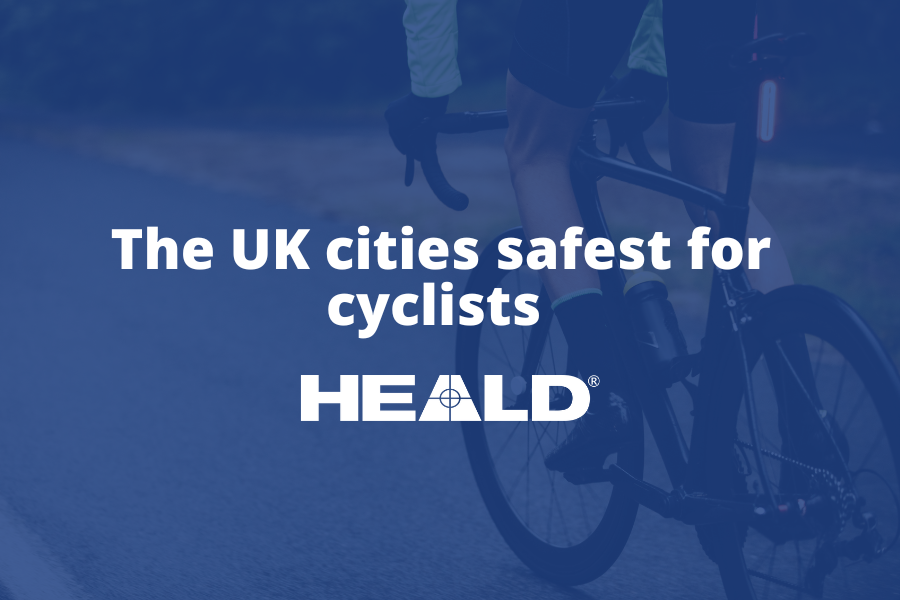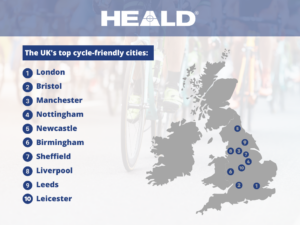Need to speak to us? Here’s our most useful number and email addresses
Sales: sales@heald.uk.com
General information: info@heald.uk.com
Marketing: marketing@heald.uk.com
Need to speak to us? Here’s our most useful number and email addresses
Sales: sales@heald.uk.com
General information: info@heald.uk.com
Marketing: marketing@heald.uk.com

As the UK’s 100th National Bike Week approaches (5-11th June), our new study reveals the top ten cities in the UK best for cycling lovers¹.
In recent years, cycling has witnessed a surge in popularity across the UK. With the ongoing emphasis on sustainable transportation and the numerous health benefits associated with cycling, urban centres have been actively investing in infrastructure and facilities to enhance the cycling experience for their residents.
Recognising the significance of this growing trend and acknowledging the cities excelling in creating an environment conducive to cycling, our new ranking considers factors such as the frequency of cycling, bike-related shops, and road cycling routes¹.
1.London
2.Bristol
3. Manchester
4. Nottingham
5. Newcastle
6. Birmingham
7. Sheffield
8. Liverpool
9. Leeds
10. Leicester

London is the most cyclist-friendly city in the UK, with an impressive number of residents cycling at least five times a week (3.10%). Additionally, with 240 bike-related shops and over 8,000 road cycling routes available within a 10-mile radius of the city, it’s evident that the cycling community in London is thriving. However, this also means that more cyclists are exposed to potential road risks, and our security experts believe that the city’s high traffic congestion warrants additional safety measures.
With this in mind, local councils must consider implementing extra bollard protection to mitigate these risks and create safer environments for all road users. By strategically placing bollards in areas prone to accidents and collisions, cities enhance safety and promote a responsible and sustainable transportation culture.
Living up to its sustainable name, Bristol ranks second in our new ranking for the most cycle-friendly city. With 4.80% of residents cycling at least five times a week, 64 bike-related shops, and 3,344 road cycling routes, Bristol is a clear haven for bike lovers.
Bristol’s infrastructure is well-designed to accommodate cyclists, with dedicated cycling lanes, shared paths, and bike-friendly road designs. However, this doesn’t solve the problem of dangerous driving, and councils should always look for new and innovative ways to improve safety.
Manchester ranks third in our new study, which is no surprise, as in recent years, the city has implemented several cycle-friendly measures, such as dedicated cycle lanes, bike-sharing schemes, and improved cycle parking facilities. The creation of the Manchester Cycleway networks also aims to provide safer and more accessible routes for cyclists. Additionally, the city has hosted events like ‘Cycle September’ and ‘Bike Week’ and is home to the British Cycling and the National Cycling Centre.
Of those surveyed by GOV.uk, 2.90% of Manchester’s population cycle at least five times a week, and there are 86 bike shops and 1,741 road cycling routes.
Nottingham boasts an impressive 61 bike-related shops and 1,800 road cycling routes, and 1.40% of those surveyed in this location by GOV.uk cycle at least five times a week. Alongside this, the city has been awarded ‘Cycle City’ status, which signifies its commitment to promoting cycling as a sustainable mode of transportation. This recognition has led to increased funding and initiatives to improve cycling facilities and encourage more people to cycle.
Also, the NET tram system in Nottingham includes integrated facilities, allowing cyclists to combine their bike trips with tram journeys. This multimodal transportation option provides flexibility and convenience for cyclists. However, despite these accomplishments, Nottingham could look to improving cycle lanes, implementing additional cycle-friendly policies, and considering hostile vehicle mitigation systems.
With 2.83% of the Newcastle population cycling at least five times a week, the city demonstrates a growing commitment to active and sustainable transportation. The thriving cycling culture is supported by its 49 bike-related shops and a vast network of 1,963 road cycling routes. The city has made some significant progress in supporting cyclists. However, additional improvements could include investing in bike maintenance stations, increasing bike parking options, and enhancing educational programs around cyclist safety.
Over the years, Birmingham has steadily improved its cycling infrastructure, including expanding its dedicated cycle lanes, paths, and greenways network. The city also hosts regular cycling events, and cyclists have access to diverse city neighbourhoods and the countryside. Out of those surveyed by GOV.uk, 1.40% cycle at least five times a week, and there are 64 bike-related shops and 2,607 road cycling routes.
Birmingham can improve its cycling infrastructure by implementing specific measures tailored to the city’s needs. Key improvements include developing an extensive network of dedicated cycle lanes, upgrading existing cycle routes with better signage and surface quality, implementing bicycle-friendly traffic calming measures in residential areas, creating segregated cycle superhighways on major commuting routes, improving cycle parking facilities, enhancing intersection safety with dedicated cycle signals and clear road markings, promoting cycling education and awareness programs, and expanding public bike-sharing schemes.
By focusing on these improvements, Birmingham can create a safer and more connected cycling network, encouraging more people to choose cycling as a sustainable mode of transportation and improving the overall cycling experience in the city.
Renowned for its hilly terrain, which presents exciting challenges and opportunities for cycling culture, Sheffield it’s a great city for cyclist enthusiasts seeking diverse routes. The northern city has 28 bike shops, an impressive 2,464 road cycling routes, while 2.20% of the city’s population cycles at least five times a week.
Specific measures that can be implemented include the development of a comprehensive network of dedicated cycle lanes, focusing on key commuting routes and popular cycling areas. These lanes should be physically separated from motor vehicle traffic to prioritise cyclist safety. Additionally, implementing traffic-calming measures, such as speed humps, raised crossings, and traffic islands, in residential areas and near schools can create a safer environment for cyclists.
Taking seventh place in our new ranking is Liverpool, which has 87 cycling shops, 1,377 road routes, and 2% of the population cycling at least five times a week. As well as this, the city centre boasts a flat topography, making it accessible for cyclists of varying abilities. While these factors are favourable for Liverpool’s cycling community, the city could improve its hostile mitigation efforts by strategically incorporating measures like bollards and barriers at sensitive locations to safeguard cycling infrastructure and protect vulnerable road users from potential vehicle intrusions.
Leeds, ranking 9th among the UK’s cycle-friendly cities, offers a range of opportunities for cyclists to thrive. The city showcases a strong cycling culture with 1.20% of the population cycling at least five times a week.
Leeds boasts 34 bike shops, catering to the needs of cyclists and providing a supportive community. The city also stands out with an extensive network of 3,014 road cycling routes, allowing cyclists to explore a variety of scenic and challenging paths.
Leicester, ranking 10th in our study, provides an excellent environment for cyclists to thrive. With 2.20% of the population cycling at least five times a week, the city showcases a strong cycling culture and a high level of participation.
Leicester is well-equipped to cater to the needs of cyclists with 24 bike shops, ensuring convenient access to equipment, repairs, and expertise. The city also offers an extensive network of 1,894 road cycling routes, providing various options for cyclists to explore and enjoy.
Embracing cycling-friendly initiatives in cities is a commendable step towards sustainable transportation and healthier communities. However, as we strive to create a cyclist-friendly environment, governing bodies must prioritise the safety of all road users. Implementing robust safety measures, such as the strategic placement of bollards or hostile vehicle mitigation, is essential to safeguard cyclists, drivers, and pedestrians.
Heald’s hostile vehicle mitigation products offer effective solutions for improving cyclist, pedestrian and driver safety in cities. Some key reasons why investing in these products can be beneficial include:
Specific products that would work well in protecting cyclists include:
Investing in our hostile mitigation products presents an opportunity for cities to prioritise the safety of cyclists, pedestrians, and drivers. With our robust design, technological advancements, and proven effectiveness, our products can contribute significantly to creating safer urban environments and promoting harmonious coexistence among road users.
It’s really important not to overlook the significance of protecting vulnerable road users while we embark on this transformative journey towards more cycle-friendly cities, and hostile vehicle mitigation should be considered a key role in this movement.
To learn more about which of our perimeter protection products are best for you, please get in touch with us here: https://www.heald.uk.com/get-in-touch/
Methodology
Heald Ltd conducted a comprehensive assessment to determine the ranking of the most cycle-friendly cities in the UK. The evaluation encompassed three key criteria:
Author: Heald
Publish date: 30th May 2023

